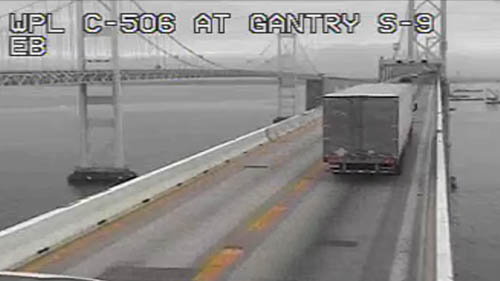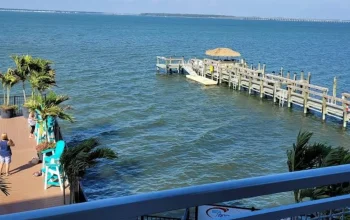 decoding=”async”
loading=”eager”
fetchpriority=”high”
sizes=”(max-width: 680px) 100vw, 640px”
/>
decoding=”async”
loading=”eager”
fetchpriority=”high”
sizes=”(max-width: 680px) 100vw, 640px”
/>
Chesapeake Bay Bridge Camera
The Chesapeake Bay Bridge, officially named after William Preston Lane Jr., is a pivotal structure in Maryland. In this article, we explore the significant benefits of the Bay Bridge MD Cameras. As we delve into their importance to enhance safety, aid in traffic management, and provide real-time updates. The Bay Bridge offers linking from the state’s western shore to the eastern shore. This impressive feat of engineering not only serves as a physical bridge but also as a symbol of overcoming decades of political hurdles and controversies.
Chesapeake Bay Bridge Traffic Cameras
Today, the Chesapeake Bay Bridge is equipped with traffic cameras that provide live feeds of traffic conditions. These cameras are crucial for monitoring and managing the flow of vehicles. Directing traffic flow is very critical during peak times such as summer weekends and holidays. These times see a significant increase of traffic due to travelers heading to Eastern Shore beach destinations. The bridge’s lane control system is particularly innovative. With lane control, this allows for adjustments in traffic patterns across the bridge’s five lanes. This flexibility is essential for handling incidents and maintaining smooth traffic flow.
MD Bay Bridge Cameras
The use of the MD Bay Bridge Cameras offers several benefits for emergency personnel when responding to a wreck or other emergencies. These real life cameras allow emergency responders to gain valuable situational awareness. Thus, this allows them to make informed decisions about the best approach to the scene of the incident.
MD Bay Bridge Cameras also offers commuters the opportunity to view real time traffic conditions on the bridge. Seeing the Bay Bridge Cameras may help a travel decide what is a better time to travel as not to get stuck in traffic.
The History of The Chesapeake Bay Bridge
The Chesapeake Bay Bridge, often called the Bay Bridge, stands as one of Maryland’s most important transportation routes. It spans 4.3 miles, connecting Annapolis on the western shore to Kent Island on the eastern shore. The bridge provides a vital link between Maryland’s more populated western regions and its rural eastern towns.
Before its construction, ferries were the only way to cross the bay. This method was slow, unreliable, and inconvenient. The bridge changed everything, making travel faster and more efficient. Named after Governor William Preston Lane Jr., the bridge was a major engineering achievement when it opened in 1952.
Early Plans and Delays
The idea of a bridge over the Chesapeake Bay dates back to the early 20th century. Officials first proposed connecting Baltimore to Tolchester Beach, but economic struggles delayed the project. The Wall Street Crash of 1929 and the Great Depression forced Maryland to put the plans on hold.
World War II further postponed construction. Military efforts and wartime priorities took center stage. However, after the war, interest in the bridge resurfaced. Traffic needs had grown, and ferry services could no longer keep up.
Governor Lane’s Leadership
In 1947, Governor William Preston Lane Jr. took action. He passed legislation to build the bridge, cutting through government red tape. His leadership made the long-discussed project a reality. By 1949, construction had officially begun.
Workers faced many challenges. The bridge had to withstand strong winds, heavy storms, and powerful water currents. Engineers designed the structure to handle these conditions. After three years of hard work, the bridge opened on July 30, 1952.
The Need for Expansion
The Bay Bridge quickly became essential for travel in Maryland. By the 1960s, traffic had increased significantly. The single span could no longer handle the growing number of vehicles. To fix this, officials decided to build a second span.
Construction of the new bridge began in 1969 and finished in 1973. This addition doubled the bridge’s capacity, reducing congestion and making travel safer. Today, the bridge carries millions of vehicles each year, especially during summer when travelers head to Ocean City and other Eastern Shore destinations.
Modern-Day Importance
The Chesapeake Bay Bridge remains a key part of Maryland’s transportation network. It supports commuters, tourists, and commercial traffic daily. The Maryland Bay Bridge Cameras provide live views, helping drivers monitor traffic and weather conditions. These cameras also offer stunning views of the Chesapeake Bay, capturing breathtaking sunrises and sunsets.
Despite its success, the bridge still faces challenges. Traffic congestion remains a problem, especially on holiday weekends. Officials continue to explore solutions, including possible expansions or a new bridge to ease travel demands.
The Chesapeake Bay Bridge stands as a symbol of progress and connectivity. It transformed travel in Maryland, replacing ferries with a modern, efficient route. Thanks to Governor Lane’s leadership, this engineering marvel became a reality. Today, it continues to serve millions, bridging the gap between Maryland’s east and west.
The Impact of the Bay Bridge on Regional Development
The Chesapeake Bay Bridge has had a profound impact on the growth and development of Maryland’s Eastern Shore. The bridge has facilitated much easier access to the beaches, turning seasonal getaways into thriving communities. Ocean City, once a quaint beach destination, has risen to become Maryland’s second most populated city. This access has not only boosted tourism but also encouraged more permanent settlements in the area, transforming the Eastern Shore’s economic and social landscape.
The Chesapeake Bay Bridge as a Cultural Icon
The Chesapeake Bay Bridge, more than just a physical structure, has grown to become a cultural icon for Maryland and a symbol of human achievement against geographical and logistical challenges. Its striking presence against the backdrop of the expansive Chesapeake Bay has made it a favorite subject for photographers and artists, who capture its majestic beauty in various forms of art and media.
Architectural Significance and Design
From an architectural standpoint, the bridge is a marvel. Its design reflects a blend of functionality and aesthetic appeal, featuring sweeping curves and towering spans that elegantly traverse the wide expanse of water. The bridge’s dual spans, while serving a practical purpose, also create a visually striking gateway between the Eastern and Western shores. This design not only meets the demands of heavy traffic but also harmonizes with the scenic views of the bay, making every crossing a memorable experience.
The Bridge in Media and Public Imagination
The Chesapeake Bay Bridge has also found its place in popular culture and media, often featured in films, television shows, and advertisements that highlight its grandeur and the dramatic landscapes it spans. The Bay Bridge has appeared in numerous film including: “The Silence of the Lambs,” “The Devil’s Advocate,” and “Aquaman.” Its image is frequently used in promotional materials that invite visitors to explore the natural and historical richness of Maryland. The bridge, thus, not only connects lands but also weaves itself into the narrative of Maryland’s identity and heritage.
Bay Bridge’s Parallel Thimble Shoal Tunnel Project
The Parallel Thimble Shoal Tunnel Project is a major upgrade to the Chesapeake Bay Bridge-Tunnel (CBBT). This project adds a new two-lane tunnel under the Thimble Shoal Channel, connecting Island #1 to Island #2. When finished, the new tunnel will carry southbound traffic, while the existing tunnel will handle northbound traffic.
This project is also historic. It will be the first transportation tunnel in the Mid-Atlantic built using a tunnel boring machine (TBM). This advanced method makes construction safer and more efficient than traditional techniques.
Why the New Tunnel is Needed
The CBBT is a key route linking Virginia’s Eastern Shore to the mainland. Spanning 17.6 miles, it connects Norfolk and Virginia Beach to points north. Since opening in 1964, traffic has grown significantly. Today, congestion is a serious issue, especially during peak travel times.
Currently, the Thimble Shoal Tunnel has only one lane in each direction. This creates delays and increases the risk of accidents. The Parallel Thimble Shoal Tunnel will ease these problems by separating northbound and southbound traffic.
How the Tunnel is Being Built
Workers are using a tunnel boring machine (TBM) to dig the new tunnel. This method is better than the old immersed tube technique, which required sinking prefabricated tunnel sections. The TBM digs through the seabed while placing precast concrete segments to form the tunnel walls.
Key Construction Challenges:
- Excavating deep under the bay while keeping the structure secure.
- Handling high water pressure to prevent leaks.
- Maintaining safe working conditions for tunnel crews.
- Keeping the existing tunnel open while building the new one.
Despite these challenges, engineers are using modern technology to ensure the tunnel is strong and safe.
How the Tunnel Will Improve Travel
When complete, the new tunnel will bring many benefits:
- Less Traffic Congestion: Separate tunnels for each direction will improve traffic flow.
- Better Safety: Dividing traffic will reduce head-on collision risks.
- More Reliable Travel: The extra tunnel provides an alternative if one tunnel needs repairs.
- Stronger Economy: Smoother travel will help businesses, tourism, and freight transport.
Project Timeline and Progress
Construction started in 2017. Engineers and workers have spent years preparing the site, assembling the tunnel boring machine, and manufacturing tunnel sections. However, delays from weather, environmental issues, and material shortages have pushed back the schedule. Officials expect the tunnel to open in the next few years.
The Parallel Thimble Shoal Tunnel Project is a vital improvement to the Chesapeake Bay Bridge-Tunnel. By adding a second tunnel under the Thimble Shoal Channel, this project will make travel safer, faster, and more reliable. It also represents a milestone as the first Mid-Atlantic tunnel built with a tunnel boring machine. Once complete, the CBBT will continue to serve as a critical link between Virginia’s Eastern Shore and the mainland.
Looking Toward the Future
As we look to the future of the Chesapeake Bay Bridge, plans for maintenance, upgrades, and possibly even expansion are continually evaluated. The bridge must adapt to the challenges of modern transportation demands and environmental sustainability. Discussions about infrastructure improvement reflect Maryland’s foresight and commitment. Likewise, this ensures that the bridge continues to serve its purpose efficiently and safely in the years to come.
Conclusion: The Chesapeake Bay Bridge as a Catalyst for Change
The Chesapeake Bay Bridge has stood as a testament to human ingenuity and determination. Its construction overcame significant political and economic challenges. Furthermore, its very existence has reshaped the demographic and economic contours of Maryland. As we look towards the future, the Chesapeake Bay Bridge continues to serve as a critical artery with commerce, tourism, and daily travel. The bridge maintains its role as a vital link for cargo, commuters, and travelers over the Chesapeake Bay. Bay Bridge MD Cameras keeps travelers connected from any computer or smart device.


